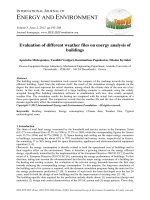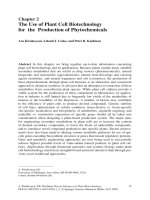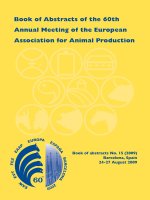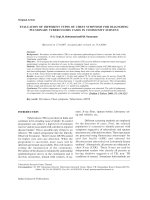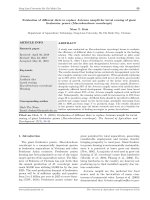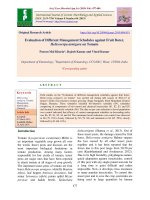Evaluation of different litter materials for broiler production
Bạn đang xem bản rút gọn của tài liệu. Xem và tải ngay bản đầy đủ của tài liệu tại đây (154.46 KB, 5 trang )
Int.J.Curr.Microbiol.App.Sci (2018) 7(12): 1041-1045
International Journal of Current Microbiology and Applied Sciences
ISSN: 2319-7706 Volume 7 Number 12 (2018)
Journal homepage:
Original Research Article
/>
Evaluation of Different Litter Materials for Broiler Production
A.P.S. Dhaliwal, Balwinder Singh Dhillon* and J.S. Brar
Krishi Vigyan Kendra, Bathinda-151 001, Punjab, India
*Corresponding author
ABSTRACT
Keywords
Broiler birds, Feed
conversion ratio,
Litter materials,
Moisture content
Article Info
Accepted:
10 November 2018
Available Online:
10 December 2018
The aim of this study was to determine the selection of bedding material used in broiler
birds during the rearing period. Total 72 broiler chicks of IBL-80 were used on a
completely randomized design in four treatments of deep litter materials i.e. wheat straw,
rice husk, mustard stalk and sand. This study includes four treatments along with three
replicates and each replicate consists of 18 birds. Standard feeding and management
practices were followed during the experimental period. Differences in average weight
gain, feed consumption, feed conversion ratio (FCR) and dressing percentage of wheat
straw, rice husk, mustard stalk were significantly higher than sand, while, mortality was
higher in sand treatment. The moisture content increased from 8.15 to 40.4% in wheat
straw, 11.4 to 45.3% in rice husk, 7.80 to 38.7% in mustard stalk and 2.2 to 17.4% in sand
during the study. The cost of litter for rearing one bird in deep litter system was Rs. 1.74,
1.53, 1.45 and 1.68 for sand, mustard stalk, rice straw and wheat straw respectively. It was
concluded that any of these three bedding materials (wheat straw, rice husk and mustard
stalk) may be used and these are cheap and locally available to the poultry entrepreneurs.
Overall rice husk gives excellent results as they have the ability to absorb the moisture and
remain dry which is the basic requirement of deep litter system. The manure quality of rice
husk is very excellent as compare to other materials.
Introduction
Poultry is the most organised sector in animal
production system. The growth is 6-8% in
layers and 10-12% in broilers per year against
the growth of agriculture as a whole which is
around 2.5%. Within a span of 25 years, the
egg production has gone up to 70 billion from
few millions and the broiler production has
gone to 3.8 million tonne from nowhere. India
is the third-largest egg producer after China
and USA and the fourth-largest chicken
producer after China, Brazil and USA. The per
capita eggs consumption has gone up from 30
to 68 and the chicken from 400 gm to 2.5 kg.
To obtain maximum meat production,
management in the poultry house is very
essential. One of the management practices is
the proper maintenance of poultry litter
commonly named as deep litter system of
management. The litter material is used in a
poultry farm to give more comfort to the birds
1041
Int.J.Curr.Microbiol.App.Sci (2018) 7(12): 1041-1045
for best profitable outcomes. The quality of
litter material significantly influences the
overall performances of the broilers as well as
the chickens. A good litter serves as an
insulator to maintain uniform temperature
round the year and also acts as a blotter
through absorbing the extra moisture of the
feces and urine by increasing surface area of
the floor which prevents fungal contamination.
The quality of litter significantly influences
the overall performance and ultimately the
profit. Litter plays a vital role in absorbing the
fecal moisture, promotes drying by increasing
surface area of the house floor, insulates chick
from cooling effects of the ground and provide
a protected cushion. Litter material helps to
conserve heat by insulation and provide
supplemental heat through fermentation by
feacal microorganisms. It receives droppings
and absorbs moisture from faeces and
respiratory processes. It provides a warm, soft
and spongy surface for optimum comfort of
the birds.
A variety of litter material including paper
products (Lien et al., 1992), gypsum (Grimes
et al., 2007), hardwood bark (Brake et al.,
1992), sand (Shields et al., 2005), rice and
wheat straw (Sreehari and Sharma 2010),
ground corn cob and soybean straw (De Avila
et al., 2008) have been used as substitute
bedding materials with various level of
success. Particle size, absence of dust, bulk
density, thermal conductivity, drying rate and
compressibility make pine shavings an ideal
bedding material for broilers and layer birds.
Therefore, the first aim of the present research
was to assess the selection by rearing egg
laying birds in different types of materials
widely used as litter in the poultry industry
(wheat straw, rice husk, mustard stalk (Phulk)
and sand). The second objective of this study
was to determine the predominant behaviours
on each of these materials. Moreover, the
characteristics of the materials used as broiler
substrate must be taken into account, because
some substrates may enrich the environment
and support important behaviours of the birds
(Gunnarson et al., 2000), as well as determine
chickens’ skin condition (Mendes et al.,
2011). Thus, providing a good litter would be
an effective way to increase broiler activity
(Shields et al., 2005) and to reduce
locomotion problems (Almeida Paz et al.,
2010).
Materials and Methods
Experiment details
The experiment was conducted at Poultry Unit
of Krishi Vigyan Kendra (KVK), Bathinda
(Punjab, INDIA). Four (12 m × 10 m) broiler
houses were internally divided in four pens
each. For the present study day old chicks of
IBL-80 procured from GADVASU, Ludhiana
were reared. There were four treatments of
litter material i.e. wheat straw, rice husk,
mustard stalk (Phulk) and sand and each
treatment was then replicated three times of 18
chicks each in Completely Randomized
Design (CRD). The chicks were routinely
vaccinated and reared under strict hygienic
conditions
maintaining
all
standard
managemental practices including brooding,
proper lighting, raking of litter, cleaning of
feeders and drinkers etc. The birds belonging
to all the experimental groups were closely
observed throughout the experiment, starting
from day old till the end of experiment i.e. 56
days (8 weeks) of rearing birds.
Data recording
The gain in body weight for each bird was
recorded on weekly basis by subtracting the
initial body weight from the weight recorded
at the seventh day of each week. The feed and
water was offered ad libitum and the leftover
feed was recorded at next morning. Feed
consumption was calculated for each group by
subtracting the leftover feed from the feed
1042
Int.J.Curr.Microbiol.App.Sci (2018) 7(12): 1041-1045
offered. The feed conversion ratio (FCR) for
each replicate on weekly basis was calculated
by dividing the mean weekly total quantity of
feed consumed by the mean weekly total gain
in body weight. At the end of the experiment,
the birds were kept fasting for 5-6 hours and
no feed was offered during this withdrawal
period to keep the crop of the bird empty at
slaughtering time. Three birds were randomly
selected from each replicate, weighed and
immediately slaughtered. After removing
feathers along with the skin, head, legs and all
internal organs including heart, gizzard, liver
and abdominal fat, the carcass was weighed to
determine dressing percentage. Mortality was
recorded daily. The dead birds were dissected
to determine the causes of death. Samples of
litter were taken in plastic bags from each
replicate on weekly basis to determine the
amount of moisture. Water absorbing or
holding capacity was determined according to
procedure described by Davasgaium and
Boodoo (2000). Economics of each litter
material was calculated according to
prevailing market prices at the time of the
trial.
that birds reared on rice husk gained the
highest body weight followed by those on
mustard stalk and wheat straw. But average
weight gain and feed consumption of birds
reared in the rice husk, wheat straw and
mustard stalk were significantly higher than
sand. Feed consumption of the birds reared on
different litter materials i.e. rice husk, wheat
straw and mustard stalk was more or less
similar, although birds on saw consumed the
lowest amount of feed. This is in agreement
with the findings of Davasgaium and Boodoo
(2000).
Feed consumption ratio of birds reared on
mustard stalk was significantly higher than
sand, but statistically similar with rice husk
and wheat straw. Dressing percentage of birds
reared on sand was significantly lower than
rice husk, wheat straw and mustard stalk.
There was no significant difference (P<0.05)
between the rice husk, wheat straw and
mustard stalk in dressing percentage.
Mortality not differed significantly among rice
husk, wheat straw, mustard stalk and sand.
However, higher mortality was recorded in
sand treatment.
Data analysis
The data were statistically analyzed with the
standard procedures of Analysis of Variance
(ANOVA), using Completely Randomized
Design, as described by Steel and Torrie
(1981). The means were compared for
significance of difference with the Duncan’s
Multiple Range Test for variables. The
statistical package (SAS, 2000) was used to
perform the above analysis.
However, the better livability was found on
sawdust and rice husk (100%) which was
supported by Hussain et al., (1996) and Kassid
and Coleman (1990).
The average recorded temperature and
Relative humidity were 29.55°C and 78.73%
respectively during experimental period.
Manureal value of different litter materials
(N, P and K content)
Results and Discussion
Growth performance of birds
There was no significant difference (P<0.05)
between the rice husk, wheat straw and
mustard stalk in average weight gain and feed
consumption (Table 1). However, it was found
Rice husk contained the highest percentage of
moisture followed by wheat straw, mustard
stalk and sand (Table 2). The significant
difference was found for nitrogen, phosphorus
and potassium content among different types
of used litter. The maximum values of
nitrogen, phosphorus and potassium content
1043
Int.J.Curr.Microbiol.App.Sci (2018) 7(12): 1041-1045
were recorded in rice husk. Similar results
were also found earlier by Monira et al.,
(2003). In this study used rice husk appeared
to be best manure in respect of nitrogen,
phosphorus and potassium content.
Table.1 Performance of broilers reared on four types of litters up to 56 days of age
Parameters
Avg. weight gain
(g/bird)
Feed consumption
(g/bird)
Feed conversion ratio
(feed:grain)
Dressing percentage
Mortality
Wheat
straw
1608.04 a
Types of litter
Rice husk
Mustard stalk
Sand
1625.03 a
1612.07 a
1602.09 b
3952.00 a
4066.00 a
3995.00 a
3920.00 b
2.46 ab
2.48 ab
2.50 a
2.45 b
70.56 a
0a
75.23 a
0a
72.40 a
0a
65.15 b
4a
Means in the column with similar superscripts are not significantly different at P<0.05
Table.2 Manureal value of different litter materials
Parameters
Week 1
Moisture
content
Week 8
(%)
Nitrogen (%)
Phosphorus (%)
Potassium (%)
Wheat
straw
8.15 b
40.4 b
2.20 b
0.98 b
0.25 b
Types of litter
Rice husk
Mustard stalk
Sand
11.4 a
45.3 a
7.80 b
38.7 b
2.2 c
17.4 c
3.40 a
1.35 a
0.32 a
1.80 c
0.85 b
0.23 b
1.53 d
0.78 c
0.18 c
Means in the column with similar superscripts are not significantly different at P<0.05
Table.3 Economics of different litter materials
Types of litter
Wheat straw
Rice husk
Mustard stalk
Sand
Amount
required/ft2
(kg)
0.7
0.5
0.9
2.9
Price/kg
(Rs)
Price/ft2
(Rs)
Price/1000 ft2
(Rs)
2.4
2.9
1.7
0.6
1.68
1.45
1.53
1.74
1680
1450
1530
1740
1044
Int.J.Curr.Microbiol.App.Sci (2018) 7(12): 1041-1045
Economics of different litter materials
Economics of the four different bedding
materials was calculated on the basis of market
prices at the time of trial. Keeping the standard
floor space of one square foot per broiler, prices
of different litter materials were calculated. The
cost of wheat straw, rice husk, mustard stalk
and sand was Rs. 1680, 1450, 1530 and 1740,
respectively for rearing 1000 broiler chicks
(Table 3). The rice husk had an edge on wheat
straw, mustard cake and sand due to its very
high moisture absorbing ability, rice husk is
also better than wheat straw, mustard cake and
sand in respect of availability and economics.
References
Almeida Paz, I.C.L., García, R.G., Bernardi, R.,
Näas, I.A., Caldara, F.R., Freitas, L.W.,
Seno, L.O., Ferreira, V.M.O.S., Pereira,
D.F. and Cavichiolo, F. (2010) Selecting
appropriate bedding to reduce locomotion
problems in broilers. Braz. J. Anim. Sci. 12
(3): 189-195.
Avila, V. S., U. Oliveira, E. A. P. Figueiredo, C.
A. F. Costa, V. M. N. Abreu, and P. S.
Rosa. 2008. Avaliação de materiais
alternativos em substituição à maravalha
como cama de aviário. Braz. J. Anim. Sci.
37: 273–277.
Brake, J.D., Fuller, M.J., Boyle, C.R., Link, D.E,
Peebles, E.D. and Latour, M.A. (1993).
Evaluations of whole chopped kenaf and
kenaf core used as a broiler litter material.
Poult. Sci. 72: 2079-2083.
Davasgaium, M.M. and Boodoo, A.A. (2000).
Use of bagasse as a potential source of litter
material for broiler production. Internet
address:
/>/html/p18txt.htm.
Grimes, J.L., Carter, T.A., Godwin, J.L. (2006).
Use of a litter material made from cotton
waste, gypsum, and old newsprint for
rearing broiler chickens. Poult. Sci. 85:
563-568.
Gunnarsson, S., Matthews, L.R., Foster, T.M. and
Temple, W. (2000). The demand for straw
and feathers as litter substrates by laying
hens. Appl. Anim. Behavior Sci. 65: 321330.
Hussain, S.A., Zahid, S., Akhtar S. and Saleem,
K. (1996). Effect of different types of litter
materials on the performance of broilers.
Pak. J. Zool. 28: 181-182.
Kassid, I.F.H. and Coleman, T.H. (1990). The
effect of using anaphage (D.P.W.) or
shavings as litter. Poult. Abstr. 16: 54.
Lien, R.J., Conner, D.E. and Bilgili, S.F. (1992).
The use of recycled paper chips as litter
material for rearing broiler chickens. Poult.
Sci. 71: 81-87.
Mendes, A.S., Paixao, S.J., Restelatto, R.,
Reffatti, R., Possenti, J.C., de Moura, D.J.,
Morello G.M.Z. and Carvalho, T.M.R.
(2011). Effects of initial body weight and
litter material on broiler production. Braz.
J. Poult. Sci. 13 (3): 165-170.
Monira, K.N., Islam, M. A., Alam, M. J. and
Wahid, M.A. (2003). Effect of litter
materials on broiler performance and
evaluation of manureal value of used litter
in late autumn. Asian-Aust. J. Anim. Sci. 16
(4): 555-557.
SAS (2000) Institute. SAS User’s guide: Statistics
version 9.0.
Shields, S.J, Garner, J.P, Mench, J.A. (2005).
Effect of sand and wood-shavings bedding
on the behavior of broiler chickens. Poult.
Sci. 84: 1816-1824.
Sreehari, S. and Sharma, R.K. (2010). Effect of
litter type and stocking density on the
performance of broilers. Indian J. Poult.
Sci. 45 (1): 105-107.
Steel, R.G.D. and Torrie, J.H. (1981). Principles
and procedures of statistics: A biometrical
approach. 2nd Ed. McGraw-Hill, Singapore.
How to cite this article:
Dhaliwal, A.P.S., Balwinder Singh Dhillon and Brar, J.S. 2018. Evaluation of Different Litter Materials
for Broiler Production. Int.J.Curr.Microbiol.App.Sci. 7(12): 1041-1045.
doi: />
1045

